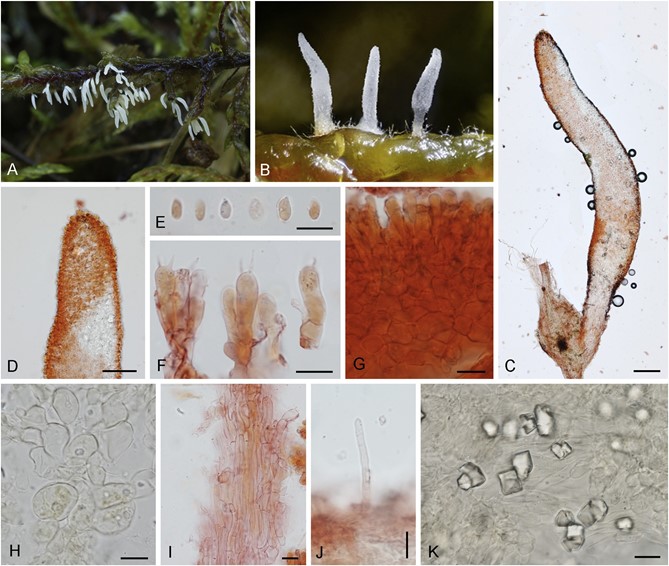Bryopistillaria sagittiformis (Pat.) Olariaga, Huhtinen, Læssøe, J.H. Petersen & K. Hansen, comb. nov. Fig. 7.
MycoBank number: MB 831378; Index Fungorum number: IF 831378; Facesoffungi number: FoF;
Basionym: Pistillaria sagittiformis Pat., Tab. Anal. Fung. 1: 26. 1883 [“sagittæformis”]
Synonym: Ceratellopsis sagittiformis (Pat.) Corner, Ann. Bot. Mem. 1: 206. 1950. [“sagittæformis”].
Basidiomata gregarious or caespitose in groups of 2– 5 basidiomata, 0.7 – 1.2 mm high, simple, with a short stipe. Fertile part narrowly claviform, sharply delimited from the stipe, white, 0.6 – 0.1 × 0.15 – 0.3 mm. Stipe short, cylindrical, glabrous or with sparse hairs, hyaline white, 0.1 – 0.4 × 0.1 – 0.2 mm. Subiculum spreading out on the substratum among basidiomata. Apex pointed and sterile in very young basidiomata, hyaline white, then obtuse and fertile. Basidiospores ellipsoid, sometimes in tetrads, hyaline, smooth, without iodine reactions, 4.5 – 6.5(– 8) × 3– 3.5(– 4) μm. Basidia claviform, (1 – 2–)4- spored, 16– 23 × 4.5 – 7 μm, clampless. Subhymenium composed of globose to subglobose hyphae, thin-walled, hyaline, 4– 10(– 12) μm broad. Generative hyphae cylindrical to fusiform, hyaline, thin-walled, clampless, 2.5 – 6(– 9) μm broad, without iodine reactions. Hyphae on the stipe surface cylindrical, thin-walled, clampless, 3 – 3.5 μm broad. Caulinar hairs sparse, cylindrical, thin-walled, up to 50 × 3 μm. Subiculum formed by cylindrical hyphae, thin-walled, straight, branching at right angles, clampless, 3– 4 μm broad. Skeletal hyphae absent. Crystals sometimes present among the medulla hyphae, bipyramidal or sphaeroid. Attempts to obtain cultures from shed spores on MEA unsuccessful.
Typus: Lectotype designated here: Patouillard, Tab. Anal. Fung. 1: fig. 56. 1883. MycoBank MBT389355. Estonia, Otepää, Karula National Park, Peräjärve forest trail, on living Pleurozium schreberi, 13 Sep. 2015, I. Olariaga, IO.15.85 (S, epitype designated here; isoepitype in UPS). MycoBank MBT387918.
Known distribution: Denmark, Estonia, Finland, France, Sweden.
Additional materials examined: Denmark, Lolland, Biowide plot 120, Hejrede Sø, 5 Nov. 2014, T. Læssøe & T. Smidth, DMS-695059 (C); Sjælland, Allindelille Fredskov, on dead stem of Alnus, 20 Oct. 1977, H. Knudsen, C-F-124736; Amager Strandpark, on moss, 17 Nov. 2014, T. Læssøe, C-F-113951; Asserbo Plantage, on damp Juniperus bark and living mosses, 28 Feb. 2019, O. Martin, DMS-10005573 (C); Vestskoven, on damp Juniperus bark and mosses, 14 Feb. 2018, T. Kehlet, DMS-9242450 (C); Biowide plot 079, Melby Hede, 6 Nov. 2014, T. Læssøe, DMS-695405 (C); Biowide Plot 070, Gjessøvej, on moss, 31 Aug. 2015, T. Borgen & T. Læssøe, C-F-114679; Biowide plot 120, Hejrede Sø, base of Poaceae plant, 5 Nov. 2014, T. Læssøe & T. Smidth, C-F-114417; Strødam Reservatet, on mosses, rotten leaves and bark, 8 Nov. 2003, T. Læssøe, DMS- 398331(C); Jægersborg Dyrehave, on moss and algae, 20 Jun. 1998, T. Læssøe, DMS-384562 (C-F-38168); Møns Klinteskov, v. Nælderenden, on moss on branch in damp hole, 23 Oct. 1971, H. Knudsen, C-F-94572; Stabjerggård, on Tortula, 14 Nov. 1976, H. Knudsen, C-F-94573. Finland, Pohjois-H€ame, Laukaa, Hallal€ahde, on water dripping hillside west of the spring, on stock covered with moss, abundant on Pleurozium schreberi, 14 Sep. 2004, T. R€am€a (TUR 178089). France, Pyr´en´ees atlantiques, Escot, Le Barescou, on living mosses, 8 Oct. 2016, I. Olariaga (ARAN-Fungi 4625). Sweden, Dalarna, S€arna, ca. 1.5 km W from Kryptj€arnen, on living Thuidium tamariscinum and Plagiomnium, spreading on a dead herbaceous culm, 31 Aug. 2015, I. Olariaga, IO.15.41 (S); Skåne, Eriksdal, Vitab€acksk€allan Nature Reserve, on living leaves of Scorpidium cossonii, 3 Oct. 2014, N.-O. Nilsson & I. Olariaga, IO.14.164 (S); Skåne, Tomelilla, Årupk€arrets Nature Reserve, on living Scorpidium cossonii, in a fen, 3 Oct. 2014, N.-O. Nilsson & I. Olariaga, IO.14.163 (S); Uppland, Uppsala, the cemetery wall, southeast corner adjacent to Carolinaparken, on low mosses (Tortula ruralis), 12 Sep. 1932, S. Lundell (UPS F-152985, as Ceratellopsis cf. sagittiformis).
Notes: The original plate of B. sagittiformis shows a fungus with a fertile apex, 2-spored basidia and aseptate medulla hyphae reminiscent of skeletal hyphae. Corner (1950) suggested this plate might correspond to a Pterula species, but this view cannot be verified, as no type specimen appears to exist in the Patouillard herbarium (FH, PC). Instead, we interpret B. sagittiformis, as a species with obtuse fertile basidiomata at least when not extremely young, medulla hyphae 3 – 4 μm broad, lacking clamp connections and occurring usually, though apparently not strictly, on living mosses (Hansen & Knudsen 1997). It is possible that mosses are always present but not necessarily act directly as substrate for the basidiomata. Accordingly, we propose an epitype specimen to stabilise its current interpretation (Corner 1950, Hansen & Knudsen 1997).

Fig. 7. Bryopistillaria sagittiformis (epitype, IO.15.85, S). A. Basidioma growth habit. B. Close-up of basidiomata. C. Basidioma observed using a light microscope. D. Close-up of basidioma apex. E. Basidiospores. F. Basidia. G. Hymenium section showing a subhymenium with globose to sugblobose cells. H. Subhymenium cells. I. Thin-walled septate medullar hyphae. J. Caulinar hair. K. Crystals. Mounting media were Melzer’s reagent (H, K) and Congo Red in ammonia (C–G, I– J). Scale bars: C = 100 μm; D = 50 μm; E–K = 10 μm. Photographs I. Olariaga, except B–C by J.H. Petersen.
